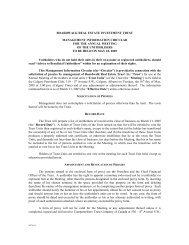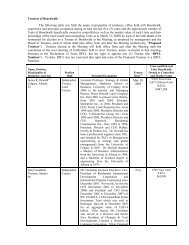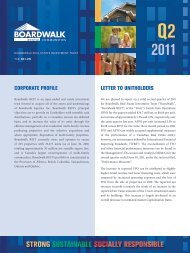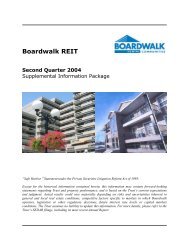BMO Financial Group - Outlook 2005(1.1Mb pdf File) - Boardwalk REIT
BMO Financial Group - Outlook 2005(1.1Mb pdf File) - Boardwalk REIT
BMO Financial Group - Outlook 2005(1.1Mb pdf File) - Boardwalk REIT
You also want an ePaper? Increase the reach of your titles
YUMPU automatically turns print PDFs into web optimized ePapers that Google loves.
34<br />
Russia also has the market concerned that<br />
restructuring of that company and the process<br />
of ownership change could disrupt close to one<br />
million barrels per day of production. The<br />
market is also worried about the possibility of<br />
an overthrowing of the Saudi government by<br />
strongly anti-western factions. All of these risks<br />
have made the market very nervous about<br />
supply adequacy, adding a very large premium<br />
to oil prices – which has bounced about in the<br />
US$10-$20/barrel range during the past couple<br />
of months.<br />
At their current level of close to US$53/barrel<br />
(October 8), oil prices incorporate a risk factor<br />
estimated at $18/barrel. Some sources of risk<br />
have been diminishing. The apparent<br />
resolution of the presidential recall in<br />
Venezuela in favour of Chavez has reduced<br />
that source of supply risk for the time being.<br />
Additionally, the market is attaching a lower<br />
probability that the Yukos affair will significantly<br />
disrupt production and exports in Russia, even<br />
though the company, unable to pay<br />
transportation fees, had to suspend a small<br />
amount of exports to China. However,<br />
Hurricane Ivan’s substantial damage to oil<br />
producing infrastructure in the Gulf of Mexico<br />
and recent indications that rebel actions<br />
against the Nigerian government could intensify<br />
have maintained a strong bid in the oil market.<br />
In Nigeria, oil production has been running<br />
around 2.4 mmb/d.<br />
Looking ahead, we expect the risk premium to<br />
diminish gradually during the next couple of<br />
years. Notwithstanding recent developments,<br />
risk related to Yukos production and exports is<br />
likely to be eliminated within the next few<br />
months. While risks to Iraqi production and<br />
exports are likely to remain pronounced, they<br />
are projected to diminish gradually as some<br />
progress is made on the political front and the<br />
new regime’s operating experience increases.<br />
Looking at the market fundamentals, current<br />
high prices and raised expectations about<br />
longer-term prices have greatly improved the<br />
economics of existing projects and are likely to<br />
stimulate new exploration, development, and<br />
production globally. Production in the Former<br />
Soviet Union and Africa is growing at a brisk<br />
pace, Saudi Arabia and other countries in the<br />
Gulf are investing to expand their capacity, and<br />
tar sands production in Canada is rising. High<br />
prices are also likely to rein in consumption,<br />
which responds with lengthy lags. Thus, there<br />
should be fairly well balanced market<br />
conditions during the next few years, although<br />
there could be some tightness this winter.<br />
Based upon IEA estimates and assuming<br />
OPEC continues to produce at its current level,<br />
global supply of oil would rise by 1.9 mmb/d to<br />
85.0 mmb/d in <strong>2005</strong>. A large part of that<br />
increase would emanate from the Former<br />
Soviet Union (rising 0.6 mmb/d in <strong>2005</strong><br />
following average increases of 0.9 mmb/d<br />
during the past two years) and OPEC (also up<br />
an estimated 0.6 mmb/d). Output in non-OPEC<br />
Africa is slated to rise 0.4 mmb/d next year.<br />
The expected increase in global supply next<br />
year should be more than sufficient to meet<br />
rising consumption, which is expected to run at<br />
83.9 mmb/d, and add to global inventories.<br />
Overall, we expect the price of WTI to decline<br />
from current levels to an average somewhere<br />
in the range of US$33-US$38/barrel in <strong>2005</strong><br />
and US$28-$33/barrel in 2006. Average prices<br />
during the next couple of years would be at the<br />
lower end of those ranges if the current turmoil<br />
in Iraq diminishes. Given unsettled political<br />
conditions in several oil producing regions and<br />
the oncoming winter heating season, progress<br />
towards lower prices is likely to be bumpy.<br />
Given very tight margins of excess capacity,<br />
unexpected shocks on the supply or demand<br />
sides could lead to substantial price volatility<br />
during the next couple of years.<br />
Earl Sweet, Assistant Chief Economist<br />
416-867-4823<br />
earl.sweet@bmo.com
















